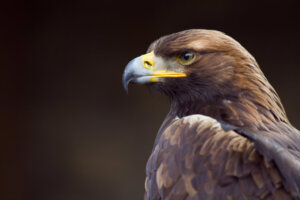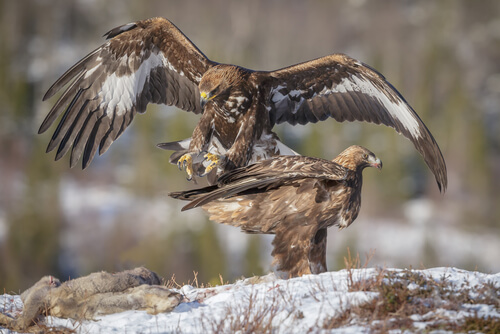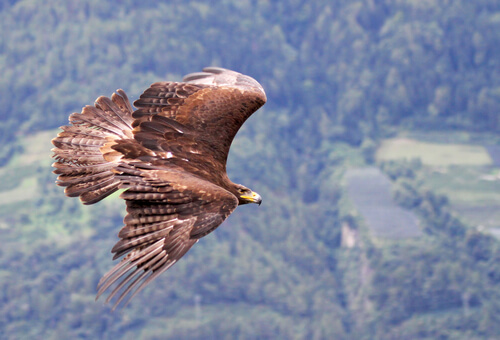9 Curiosities About the Golden Eagle's Vision


Written and verified by the biologist Cesar Paul Gonzalez Gonzalez
This group of birds is often renowned for its great visual ability. Thanks to it, they’re able to locate their prey even when they’re flying several meters above the ground. In fact, some experts consider the eyesight of eagles and hawks to be so incredible that they have tried to imitate it in order to take advantage of their potential. Discover some fascinating facts about the golden eagle’s vision in today’s article.
One of the birds with the most developed eyes in their group is the golden eagle (Aquila chrysaetos). This powerful and imposing specimen is carnivorous, so its hunting style is based almost entirely on its visual capacity. Continue reading to find out more!
What is the golden eagle?
The golden eagle belongs to the Falconiformes order, which includes other birds of prey such as vultures, kestrels and other types of eagles. This group is characterized by an arched, sharp beak that serves to tear their food. In addition, their talons complement this activity well, as their fingers are long and strong enough to catch their prey.
This eagle is between 90 and 100 centimeters (around 3 feet) tall, with a wingspan of almost 2.3 meters long (7.5 feet). It also has a beautiful, shiny brown plumage with red hues, which becomes darker on its back and lighter on its belly.

Curiosities about the golden eagle’s vision
In order to be a good hunter, eagles need to have incredible vision. Because of this, their eyes have adapted and modified to provide them with capabilities that humans don’t have. The following list compiles some of the most curious characteristics about this bird’s vision.
1. Their eyes are almost as big as human eyes
This characteristic is an obvious feature, as their eyes occupy most of their skull. However, this doesn’t mean that their functions are the same as that of humans. Their highly developed eyes indicate that visual information is quite important for the eagle.
2. Their eyes are immobile
One of the consequences of the eagle having such large eyes in such a small skull is that they’re unable to move them as humans do. For this reason, if they want to turn to look in another direction, they need to turn their entire head and direct their eyes towards the target.
3. They’re able to see forwards and to the sides at the same time
Eagles have two focal points (fovea) in each eye. These points are responsible for allowing light to enter so that visual information can be processed. However, one of them is in charge of looking at what’s in front of it, while the other one observes what’s on the sides. In this way, although its eyes can’t move, the bird is able to see in both directions at the same time.
4. They perceive more colors than humans
One of the cells in charge of perceiving colors are the famous cones, which are usually divided into 3 types that detect red, blue, and green colors. However, the golden eagle has a fourth type of cone that’s capable of perceiving ultraviolet. This allows them to see more colors than humans. It also allows them to track their prey and capture them more easily.
5. They have a third eyelid
Like humans, the golden eagle has an upper and a lower eyelid, both with the task of protecting the eye from any problems. The only problem is that when using this protection, the bird becomes blind for a few seconds, which can be fatal for them. To avoid this, they developed a third transparent eyelid that protects their eye and allows them to see at the same time.
6. They see very well in the dark
Eagles are diurnal and usually use daylight to hunt. However, some eagles are seen feeding at night and in the dark. This isn’t impossible, as their eyesight also has a large number of rods in their eyes, giving them great night vision.
7. Its neck is flexible to better visualize its prey
As mentioned above, the golden eagle’s eyes are unable to move, so it needs to turn its entire skull to be able to observe its surroundings. For this reason, nature gave it a quite flexible neck that allows it to turn easily and adapt its vision.
8. Visual acuity is 4 to 5 times greater than that of humans
It’s estimated that the eagle’s visual acuity can be 4 to 5 times greater than that of humans. This is based on 3 main points: birds have longer eyes, their pupils are larger, and the photoreceptors (rods and cones) are more numerous.
9. The eagle is able to process more visual information per second
The golden eagle is able to reach dizzying speeds of up to 320 kilometers per hour. Because of this, its vision needs to be able to process a large amount of information per second. This is achieved thanks to the enormous number of rods in its eyes, which increase the speed with which visual information flows and make it possible to hunt prey in flight.

As you can see, the golden eagle’s vision is quite impressive and has many characteristics that you may not have known about. To top it off, it has a very striking appearance, which makes it a magnificent and special bird. Sometimes it’s incredible what nature can do, but it’s clear that it adapts to the needs of every living being.
All cited sources were thoroughly reviewed by our team to ensure their quality, reliability, currency, and validity. The bibliography of this article was considered reliable and of academic or scientific accuracy.
- González-Martín-Moro, J., Hernández-Verdejo, J. L., & Clement-Corral, A. (2017). El sistema visual de las rapaces diurnas: revisión actualizada. Archivos de la Sociedad Española de Oftalmología, 92(5), 225-232.
- Julivert, M. À. (2013). Las aves rapaces. Parramón Paidotribo.
- Potier, S. (2020). Visual adaptations in predatory and scavenging diurnal raptors. Diversity, 12(10), 400.
- Bodio, S. Golden Eagle-Aquila Chrysaetos. Apex, 16, 3-638.
- May, R., Åström, J., Hamre, Ø., & Dahl, E. L. (2017). Do birds in flight respond to (ultra) violet lighting?. Avian Research, 8(1), 1-10.
This text is provided for informational purposes only and does not replace consultation with a professional. If in doubt, consult your specialist.